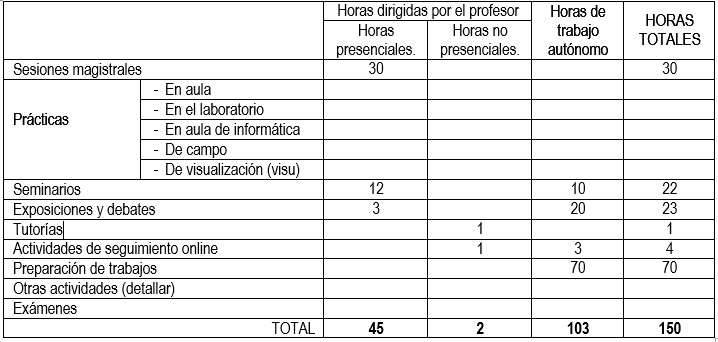SOCIAL AND POLITICAL MOVEMENTS IN A GLOBALIZING WORLD
GRADO EN ESTUDIOS GLOBALES/GLOBAL STUDIES
Curso 2019/2020
1. Subject Information
(Date last modified: 25-06-19 13:17)- Code
- 109019
- Plan
- 290
- ECTS
- 6.00
- Type
- Compulsory
- Year
- 2
- Duration
- Second semester
- Language
- ENGLISH
- Area
- SOCIOLOGÍA
- Departament
- Sociología y Comunicación
- Virtual platform
Professor Information
- Profesor/Profesora
- Kerman Calvo Borobia
- Group/s
- Único
- Centre
- Fac. Ciencias Sociales
- Office
- 410, Edificio FES
- Office hours
- (Provisional): Miércoles de 12 a 14h
- Web address
- http://diarium.usal.es/kerman/presentacion/
- kerman@usal.es
- Phone
- Ext 3520
2. Association of the subject matter within the study plan
Curricular area to which the subject matter pertains.
Basic
Professional profile.
International organizations, political analysis, political counseling
3. Prerequisites
N/A
4. Learning objectives
- To acquaint students with the plurality of manifestations that contentious politics take globally.
- To familiarize students with the successes and failures of social movements worldwide.
- To enable students to assess the possible consequences of ongoing dynamics of contentious politics worldwide.
5. Contents
Theory.
- Introduction: Contentious Politics, Global Movements.
- Contentious political actors in the global stage: Transnational Advocacy coalitions, global movements, global NGOs.
- Fighting for justice in the global south.
- Global causes: peace, and environmental activism.
- Social movements and identity: the global fight for gender and LGTBI equality. Religious movements.
- Cycles of contention and the diffusion of protest: From Zapatismo to Occupy!
- You have been recruited! Strategies of mobilization and participation in the global world.
- Violence and the Repression of dissent.
6. Competences acquired
Basic / General.
These are taken from the officail document on ‘competencias’, at https://www.usal.es/grado-en-estudios-globales-global-studies/objetivos
CB2. Que los estudiantes sepan aplicar sus conocimientos a su trabajo o vocación de una forma profesional y posean las competencias que suelen demostrarse por medio de la elaboración y defensa de argumentos y resolución de problemas dentro de su área de estudio.
CB3. Que los estudiantes tengan la capacidad de reunir e interpretar datos relevantes normalmente dentro de su área de estudio de para emitir juicios que incluyan una reflexión sobre temas relevantes de índole social, científica o ética.
CB5. Que los estudiantes hayan desarrollado aquellas habilidades de aprendizaje necesarias para emprender estudios posteriores con un alto grado de autonomía.
CG1 - Aplicar los conocimientos adquiridos para resolver problemas concretos en entornos nuevos o poco conocidos dentro de contextos más amplios (o multidisciplinares).
CG2 - Conocer y aplicar los distintos métodos de investigación en el ámbito de las ciencias sociales para analizar problemas en relación con su especialidad.
CG3 - Desarrollar habilidades de organización, planificación de tareas y coordinación de proyectos que faciliten el trabajo en Equipo.
Specific.
CE4 - Conocer los retos actuales para la justicia en un mundo globalizado así como el análisis de la situación de los derechos humanos en el mundo.
CE10 - Identificar y describir situaciones de pobreza y desigualdad. Identificar factores causales así como analizar la evolución y logro de distintos casos.
CE15 - Conocer las características de la acción colectiva y entender el funcionamiento de los movimientos sociales y sus principales características.
7. Teaching methods
This course will combine different strategies:
- Lectures, on key topics and important theoretical ideas. These will build on a list of ‘compulsory’ readings that will be marked in advance for each of the different topics.
- Participative discussions of texts and media material.
- In class presentations.
- Essay and exercise writing.
8. Anticipated distribution of the use of the different teaching methods

9. Resources
Reference books.
- Bennett, W. L., Della Porta, D., Diani, M., Johnson, E., Kolb, F., McAdam, D., ... & Sikkink, K. (2004). Transnational protest and global activism. Rowman & Littlefield Publishers.
- Fominaya, C. F. (2014). Social movements and globalization: How protests, occupations and uprisings are changing the world. Macmillan International Higher Education.
- Smith, J., & Wiest, D. (2012). Social movements in the world-system: The politics of crisis and transformation. Russell Sage Foundation.
- Tarrow, S. (2005). The new transnational activism. Cambridge university press.
- Tufekci, Z. (2017). Twitter and tear gas: The power and fragility of networked protest. Yale University Press.
- Kaldor, M. (2013). Global civil society: An answer to war. John Wiley & Sons.
- Smith, J. (2008). Social movements for global democracy. JHU Press.
- Guilhot, N. (2005). The democracy makers: Human rights and international order. Columbia University Press.
- Chabot, S., Ayres, J. M., & Caniglia, B. S. (2002). Globalization and resistance: Transnational dimensions of social movements. Rowman & Littlefield.
Other bibliographic references, electronic or other types of resources.
A detailed syllabus will be handed out to students at the beginning of the term.
10. Assessment
General considerations.
Students must demonstrate a sufficient level of the required general, basic and specific skills to pass the course.
Assessment criteria.
Evaluation will be based on the following criteria:
1/ Capacity to demonstrate knowledge of fundamental concepts, theories and events as explained throughout the course.
2/ Capacity to write in an adequately professional manner, showing command of the particularities of academic English.
3/ Capacity to communicate arguments, points of views and data.
4/ Regular class attendance and good in class disposition towards academic excellence.
Assessment tools.
1. “Primera calificación”
Continuous evaluation pathway (recommended, but not compulsory). When following this pathway, students must attempt at each of the three instruments (and receive, at least, a mark of 3,5 points). Failure to comply with these requirements will be conducive to students to transfer to the ‘examination’ pathway.
- 2 ‘in class evaluation exercises’ (30% each). These are NOT exams in the traditional sense; instead, they are a set of exercises (summary of arguments, analysis of press releases, etc), that students execute in class, with access to materials; some of them might include group discussions. They are are handed in in class.
- 1 group presentation (group composition depending on class size) on an academic article (20%). A list of suitable articles will be presented at the beginning of the term.
- Individual critical essay (20%), 2500-3500 words length, covering an issue picked by students that relate directly to any of the topics discussed in the course. The focus here will be (a) on fact finding, (b) on writing skills, and (c) on critical thinking on the facts exposed.
Examination pathway
- Oral or written examination (in the English language), covering the entire list of topics discussed during the term. This will be decided by the course instructor, not by the student.
2. “Segunda calificación”
Written examination (in the English language), covering the entire list of topics discussed during the term.
Assessment recommendations.
Constant work during the different activities in which the continuous evaluations is divided. Active participation in theoretical master classes and seminars.
Guidelines in the case of failing the subject.
Intense individual work with course materials.


